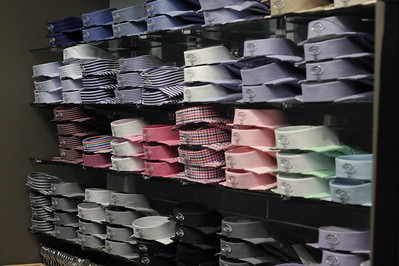 |
| Photo Credit: Menswear Market |
True style isn’t about pomp and flash, it’s a matter of getting the details right.
When it comes to dress, all elements matter, from your watch down to your socks. Your shirt selection is arguably one of the most important of these elements, so you’ll want to take the time to truly understand what each shirting fabric is ideal for.
In this post, we’ll dive deep into the nitty-gritty of men’s button down shirt fabrics. By knowing the differences between basic shirt fabrics and weaves, you’ll find selecting the right option for each occasion much simpler.
Here we’ll break down what distinguishes one fabric from another and tackle what makes each weave special. Once you understand these details, you’ll be set to look stylish and appropriate, whether you’re going to an important meeting, wedding, funeral or for work.
Fibers/Materials
Before jumping headfirst into fabrics, here’s a very brief run-through of the most common fibers you’ll find in men’s shirts.
Cotton: The majority of shirts in your closet are likely cotton, and there is good reason for that. Cotton is wonderful fiber. In addition to its softness, cotton is a natural and breathable option, thus making it easy to wear even in high temperatures. It is, however, prone to wrinkles (we’ll discuss non-iron in just a bit).
Linen: Like cotton, linen is a natural fiber. It’s even better suited than its counterpart for hot days. To boot, linen is quite beautiful, though a common complaint is that it wrinkles even more easily and those wrinkles are harder to remove than with cotton.
Polyester: A man-made fiber that is stain and wrinkle resistant. It typically isn’t used for button down shirts because it lacks body.
Rayon: A manufactured fiber that is made from naturally occurring sources. Rayon can wear like cotton or polyester, but typically needs to be cared for like wool.
Wool: Used in thicker sport shirts. Typically darker in color. Most often worn in cold weather. Needs to be dry cleaned.
Spandex: The addition of spandex to cotton shirts has become popular, but seems to cause shirts with this fabric blend to wear out faster than their all-cotton counterparts.
Fabrics (Weaves)
Poplin/Broadcloth: Poplin is a straightforward fabric consisting of a one-over and one-under weave, commonly referred to as a plain or tabby weave. This seemingly simple fabric has a smooth texture and is quite sturdy. Poplin regulates temperature well, and can work across seasons.
Due to its smoothness, it showcases patterns very crisply. It’s also quite versatile, as it can work well in formal settings as well as for daily 9-to-5 wear. Keep in mind, however, that poplin wrinkles easily.
When it comes to fabric classifications, poplin and broadcloth are often used interchangeably. Each utilizes a tabby weave structure and may appear almost indistinguishable from its sister fabric, however, there is a subtle distinction between the two. The difference is simple: poplins consist of yarns of varying sizes while broadcloths utilize only one thread size across the warp and weft.
Oxford: Durable oxford fabrics have long been popular for casual shirts and can work well in more informal business environments. Unlike broadcloths or poplins, these fabrics utilize a durable basket weave. This basket weave structure produces a thicker fabric that is often quite comfortable and warm.
Twill: It’s easy to pick out a twill fabric from among the other selections here due to the fabric’s distinctive weave. Twill showcases a beautiful diagonal pattern, unlike the more grid-like poplins or oxfords.
Twills are quite strong, are often lightweight fabrics, and they don’t easily accumulate dirt. In addition to these benefits, twill fabrics do not wrinkle as easily as several of the other options on this list.
Hounds-tooth, herringbone, and denim are all examples of commonly utilized twill fabrics. Just because your jeans consist of a twill fabric, however, don’t necessarily pass this cloth by when it comes to dress shirts. Twills tend to drape well and are more wrinkle resistant than poplins, broadcloths, and oxfords.
Chambray: Though chambray often has a denim-like appearance and durability, in fact, it consists of an entirely different weave structure. Similar to poplin and broadcloth, chambray is a tabby weave, not a twill.
The denim-esque look comes from the colors of the thread used. Rather than weave the warp and weft with the same color, chambray fabric incorporates white threads in the weft and a different color on the warp. In turn, this forms a subtle check-like pattern.
Though chambray shirts aren’t welcome in formal offices, they are often now acceptable fabrics to wear in more casual work environments, particularly in creative industries.
Non-Iron
Non-iron cotton shirts aren’t a special cotton or even a special weave. Non-iron shirts can still be ironed. When a shirt is labeled non-iron, that means the cotton was treated with a substance (that involves formaldehyde) which helps to prevent wrinkles.
With these shirt fabric basics in hand, you’re well-prepared to make the right dress choices for your workplace and lifestyle when you go shopping for new button down shirts. Each fabric and weave is ideally suited for different environments, seasons, and individual preferences.
Don’t forget to take great care of your shirts and dress shirts to keep them in top shape. At Janet Davis Cleaners, we take great pride in caring for your finest shirts. Learn more about how we take care of your button down shirts for work, special occasions, and more now.
Schedule Your Pickup or Delivery
Delivering freshly laundered clothing and items right to your door!
